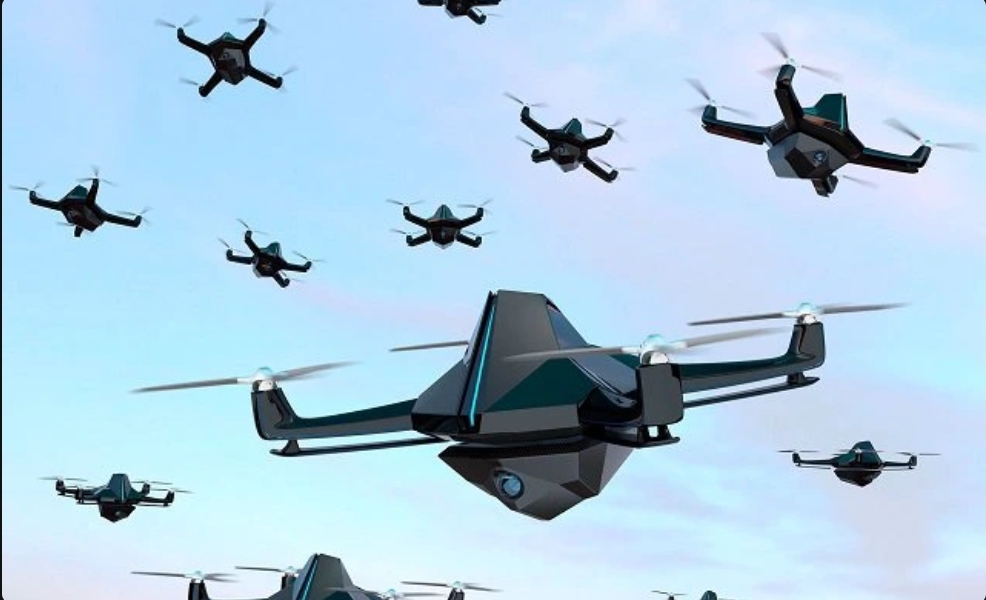“Uganda’s Next War”

Drone swarm technology has taken over modern warfare.
Advancements in unmanned aerial systems have raised debate on whether Uganda is ready for the next theatre of battle
ANALYSIS | IAN KATUSIIME | Uganda’ Sukhoi MK 30 fighter jets could be insufficient for its next war, according to the latest developments in aerial combat and military technology. In an age of drones and AI warfare, there is debate on the utility and the strategic use of the aircraft that Uganda depleted its reserves for at a cost north of US$700 million.
Advancements in unmanned aerial systems (UAS) have had military strategists re-evaluating the role of traditional air power in the form of military jets compared to drones that provide operational flexibility to armies.
The Sukhoi fighter jets were acquired from Russia in 2011 to counter eventualities in a volatile Great Lakes region. Uganda had midwifed the secession of South Sudan from Sudan and was in the early stages of the peacekeeping mission in Somalia among other geo-political shifts.
At the time of the procurement, Uganda had also set its sights on oil production as a way to diversify its economy. Fourteen years down the road, there is reckoning on Uganda’s defence posture which includes aspects of combat readiness, cybersecurity capabilities, and its military arsenal.
It is in this context that the Sukhoi MK 30 aircraft, stationed at the Entebbe Air Force Base, have come into focus. In the last three years, Uganda has sent the fighter jets for repair and maintenance to two different contractors in a sign of how expensive and inefficient the once prized aircraft have become.
The first time was in 2022 when the Uganda Peoples Defence Forces sent the jets to the Indian-state owned Hindustan Aeronautics Limited for repair. The company manufactures the jets in India under license from Russia where the jets were originally designed.
The Indian Air Force operates nearly 260 Sukhoi MK30 jets according to military analysts. The MK30 jets are treasured for their maneuverability, advanced avionics, long range and lethality. It is described as a force multiplier in the Indian Air Force arsenal.
As a bonus, India also provides the largest market for Russian weapons according to SIPRI, a defence think tank.
In 2023, two of Uganda’s jets were flown for maintenance to Belarus—a country Uganda has known military ties with. The jets arrived at Baranavichy, a city that hosts the Belarussian Air Force. Belarus also has close military cooperation with Russia. So does Uganda with Russia—in a long running military triad.
Uganda and Russia have been allies for the better part of President Yoweri Museveni’s reign that is entering the 40 year mark.
The Sukhoi jets came to represent the pinnacle of the Uganda-Russia military alliance when they were acquired. The stealth fighter jets captivated the Uganda public and enhanced the country’s aerial combat capabilities.
But critics say the jets and their costly maintenance are not fit for purpose for a poor country like Uganda that barely manages to cater for its troops welfare. There is debate on the return on investment for Uganda. The other expenses are in fuel, pilot training and logistics support.
The Sukhoi jets were once seen as the crown jewel of the UPDF but they are now deemed to represent an old order when Uganda wanted to exert air dominance particularly to keep a belligerent Sudan at bay.
Fast forward and Sudan is mired in its own conflict while Uganda’s security needs have also changed in scale and scope. Uganda also never used the jets in peacekeeping operations in Somalia.
Uganda used the Sukhoi jets to bomb the Allied Democratic Forces (ADF) in their hideouts in North Kivu in eastern Democratic Republic of Congo (DRC) after the group claimed responsibility for bomb attacks in Kampala in November 2021.
However it was about the only time they were deployed save for the occasional air display like when President Museveni was being sworn in for another term of office in 2016.
The jets have since aged and their maintenance bill is growing higher per reports. Details were scanty about the cost of the maintenance by both the Indian and Belarussian contractors but the maintenance routines are now a mainstay for the jets.
Fighter aircraft are generally expensive to maintain even for wealthy countries like Russia, China, and the U.S. as the cost of manufacture is enough to eat heavily into defence budgets, not to mention the years it takes to get them off the production line.
Drone warfare
The theatre of war has also evolved from crewed aircraft to drones and unmanned aerial vehicles (UAVs) as seen from the Russia-Ukraine conflict. However countries like Uganda still depend heavily on infantry warfare through tanks, artillery and troop battalions carrying the famed AK-47.
Military analysts say Uganda needs to invest heavily in drone acquisition to meet latter day security needs and counter threats effectively. Ukraine ramped up drone production after the Russian invasion and some estimates say the country churns out 3 million drones annually to confront the Russian war machine.
The conflict has led to the growth of Ukrainian companies like TAF Drones, Vyunnyk, The Fourth Law. These First Person View (FPV) drones give their pilots operating from different locations unique vantage points that have given Ukraine a fighting chance if not decisive advantages over a much larger and more equipped adversary like Russia.
The drones, hovering over Russian airspace and destroying tankers, are said to have been a game changer for Ukraine three years into the conflict. Their payloads contain RPGs that have become a symbol of asymmetric warfare although Ukraine has received tremendous military aid and weapons from the U.S. and other European nations.
Experts say the FPV drones provide more accuracy than artillery shells. The Bayraktar drones manufactured by Turkiye have also been deployed by Ukraine to devastating effect.
Russia has also scaled its drone use in the war: it attacked Ukraine with a swarm of more than 700 drones according to a report by Reuters in early July after US President Donald Trump pledged to send more defensive weapons to Ukraine.
Russia has also used the Iranian-made Shahed 136 drone to hit its western neighbour. Russia is also renowned for its jamming technology which it has used to counter Ukrainian drones. Drones have limited defensive capabilities making them susceptible to interceptors and surface-to-air-missiles.
DJI, a Chinese drone manufacturer, and the largest in the world, has supplied the killer robots to both sides in the conflict. It is against this backdrop that Uganda is being urged to invest in a modern drone fleet to prepare itself for the next war. The country is looking at a familiar partner.
In November 2023, UPDF and Norinco, a Chinese military contractor, broke ground to establish a UAV workshop in Nakasongola. The factory is called Anfo Production Line. The ceremony was presided over by Vincent Sempijja, then Minister of Defence, and Norinco’s Executive President Yang Xiao Qing.
Sempijja said the facility would manufacture, assemble and service drones. The minister said it would also be a Research and Development hub for drones on top of producing explosives—about 900 tonnes per month.
“Norinco is honored to be a contributor and builder of this UAV workshop,” Qing said in his remarks at the function. “We look forward to jointly building it into the UAV industrial hub of sub-Saharan Africa,” he added.
The event was attended by UPDF top brass; then Chief of Defence Forces Gen. Wilson Mbadi, National Enterprise Corporation (UPDF’s business arm) MD Lt. Gen. James Mugira, Luweero Industries MD Maj. Gen. Sabiiti Muzeyi and army spokesperson Maj. Gen. Felix Kulayigye.
Norinco and UPDF have a long history: in 1989, the company built Luweero Industries which opened in 1994 according to Mugira. The partnership ties into the strategic relationship between Uganda and China. Ugandan roads, hydropower dams, bridges and airport expansion have been built and funded by Chinese companies.
The Independent could not establish how many drones had been produced in Nakasongola a year and half later. But reports say Uganda has purchased drones from countries like Israel; the Hermes 900 drone which is “equipped with a variety of high performance sensors, allowing it to detect ground or maritime targets over a wide spectral range.”
Uganda has also reportedly acquired drones from STM Togan, a firm in Turkiye that specialises in general purpose surveillance and reconnaissance missions. According to its site, the UAVs have a 5/10km range, endurance of 45 minutes in the air and have fully autonomous operation capability.
Future of fighter jets
As Uganda ponders the future of its Sukhoi jets, debate is also raging on ambitious fighter jets. Sun Chong, the chief designer of the J15 jet in China made a proposition that the jets should be designed for regular upgrades akin to the smart phone model as reported in July in the National Security Journal.
“This vision would leverage artificial intelligence to dramatically speed up the design and manufacturing of new models, moving away from the slow, generational development cycles that currently define military aircraft,” the article stated.
The article noted that while the idea aligns with China’s rapid advancements in AI and unmanned systems, such as the new J-20s, the concept faces immense hurdles in terms of cost, complexity, and the need for constant pilot retraining.
The J15 is made by the Shenyang Aircraft Corporation, the oldest aircraft manufacturer in the People’s Republic of China. The company is now piloting the J-20, also known as the “Mighty Dragon” widely considered China’s most lethal fighter jet.
The U.S. recently announced the Next Generation Air Dominance (NGAD) fighter jet program officially designated as the F-47. President Trump revealed that the NGAD contract was awarded to Boeing in a press conference at the White House in March. The contract is expected to be worth $20 billion according to The War Zone, a defence publication. A single jet alone would cost not less than $300 million.
U.S. fighter jet programs have been criticised for how expensive they are with every new initiative running into billions of dollars. The F-22 Raptor, the F-35 are all expensive programs that take years to complete. The F-47 has been designed to replace the F-22 which is considered America’s most lethal fighter aircraft.
Trump expressed a desire to cut the costs of weapons programs in his downsizing measures.
The War Zone noted that the need for a sixth generation fighter was brought about by a potential Indo-Pacific conflict which is interpreted as a war between China and the U.S. over the small island nation Taiwan.
Uganda’s budgeting process has been tailored to support its military ambitions. Supplementary budgets and classified expenditure have become synonymous with fiscal planning in Uganda. As a result, Uganda’s budgeting process has earned a reputation for being an exercise in smoke and mirrors.
Uganda’s Ministry of Defence budget for the FY 2025/2026 is Shs3.3 trillion. But the ministry also has a development allocation totalling Shs1.9 trillion which usually flies as classified. The Ministry of Defence represents the largest convergence of force and finance since the NRM captured power in 1986. Its budget grants it the discretionary power to spend as it wishes.
Thus, UPDF carries out classified expenditure on programs that are not subject to parliamentary scrutiny such as acquisition of secret weapons and spending on classified operations in and outside of the country.
It is here that experts say Uganda’s military strategists should aim at getting a bang for its buck. Autonomous weapons are all the rage globally. U.S. defence startup Anduril Industries is one of those companies specialising in autonomous weapons systems and it is shaking up the U.S. defence industry dominated by five major defence contractors; Lockheed Martin, RTX, Northrop Grumman, General Dynamics and Boeing.
The startup that was founded in 2017 has the US Department of Defence as its biggest customer. Although Anduril is out of Uganda’s reach, drone systems readily available on the market have proved to be a good bet for Uganda whose military footprint in the Great Lakes and Horn of Africa regions is well-known.
Cost effectiveness
UAVs are praised for being cost-effective and battle ready at a moment’s notice.
“Small militias and even armies are fielding more miniature First Person View ( FPV) drones as their go-to weapon, displacing the role of artillery, anti-infantry and, at times, anti-armour weapons,” wrote Hammad Waleed on the strategic edge of low cost drones in Global Defence insight. Waleed is a Research Associate at Strategic Vision Institute based in Pakistan.
He stressed that drones are significantly cheaper than traditional military jets. “For example, an MQ-9 Reaper drone costs only a fraction of the price of any manned American Fighter Jet, such as an F-15. The same is true for China, where its Wing Loong drone systems are way cheaper than its mainstay arsenal of fighter jets (J-20 and J-11Bs).”
Waleed argued that for countries to effectively use drones, they will have to overhaul their military organisational structures and chains of command. “These units should be led by combat leaders who have undergone specialised training in AI, data systems, drone tactics, and counter-drone tactics and are empowered to make pivotal combat decisions.”









0 Comments